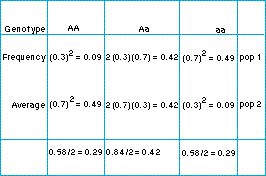The theory of natural selection (part 2) - What are the effects of population subdivisions?

Why is the frequency of homozygotes higher in populations which contain subdivisions?
Consider a simple case in which there are two populations (population 1 and population 2) and we concentrate on one genetic locus with two alleles, A and a. Suppose allele A has frequency 0.3 in population 1 and 0.7 in population 2. If the genotypes have Hardy-Weinberg ratios they will have the frequencies, and average frequencies, in the two populations shown opposite.
Now suppose that the two populations are fused together. The gene frequencies of A and a in the combined population are (0.3 + 0.7)/2 = 0.5, and the Hardy-Weinberg genotype frequencies are:
| Genotype | AA | Aa | aa |
|---|---|---|---|
| Frequency | 0.25 | 0.5 | 0.25 |
Thus the average frequencies of homozygotes for the two populations is higher than the Hardy-Weinberg frequencies that result from the two populations being fused together.
Table: The frequency of genotypes Aa and aa assuming Hardy-Weinberg ratio and that allele A has a frequency of 0.3 in population 1 and 0.7 in population 2.
| Next |



